Improvement of Corrosion and Wear Resistance of CoCrNiSi0.3 Medium-Entropy Alloy by Sputtering CrN Film
Abstract
:1. Introduction
2. Materials and Methods
2.1. Materials
2.2. Characterization
3. Results and Discussion
3.1. Microstructure of CoCrNiSi0.3 MEA
3.2. Wear and Corrosion Resistance of CoCrNiSi0.3 MEA
3.3. Characterization of Sputtered CrN Films
3.4. Wear and Corrosion Resistance of CoCrNiSi0.3 MEA with Sputtered CrN Films
3.5. TEM Observation of CrN Films
4. Conclusions
- The annealed CoCrNiSi0.3 MEA exhibits a single-phase FCC structure, and plenty of annealed twins are also observed in the grains. The grain refinement of CoCrNiSi0.3 MEA improves the hardness and wear resistance but decreases the corrosion resistance.
- Through the depositing of the Cr buffer layer, a super-hard CrN film is successfully deposited on the soft CoCrNiSi0.3 substrate. The deposited CrN films exhibit a columnar grain structure. With the increase in deposition time, the width of columnar grains decreases and the average surface roughness of CrN films increases.
- With the increase of sputtering time, the increase of CrN film thickness, and the refinement of columnar grains, both wear and corrosion resistance improve simultaneously.
- In this study, CoCrNiSi0.3 MEA with 3 h-sputtered CrN film has the lowest wear rate of 2.249 × 10−5 mm3·m−1·N−1, and the best corrosion resistance of Icorr 19.37 μA·cm–2 and Rp 705.85 Ω·cm2.
Author Contributions
Funding
Institutional Review Board Statement
Informed Consent Statement
Data Availability Statement
Acknowledgments
Conflicts of Interest
References
- Tsai, M.-H.; Yeh, J.-W. High-Entropy Alloys: A Critical Review. Mater. Res. Lett. 2014, 2, 107–123. [Google Scholar] [CrossRef]
- Kim, J.H.; Lim, K.R.; Won, J.W.; Na, Y.S.; Kim, H.-S. Mechanical Properties and Deformation Twinning Behavior of As-Cast CoCrFeMnNi High-Entropy Alloy at Low and High Temperatures. Mater. Sci. Eng. A 2018, 712, 108–113. [Google Scholar] [CrossRef]
- Prasad, N.; Bibhanshu, N.; Nayan, N.; Avadhani, G.S.; Suwas, S. Hot Deformation Behavior of the High-Entropy Alloy CoCuFeMnNi. J. Mater. Res. 2019, 34, 744–755. [Google Scholar] [CrossRef]
- Shun, T.T.; Du, Y.C. Microstructure and Tensile Behaviors of FCC Al0.3CoCrFeNi High Entropy Alloy. J. Alloys Compd. 2009, 479, 157–160. [Google Scholar] [CrossRef]
- Yang, X.; Zhang, Y. Prediction of High-Entropy Stabilized Solid-Solution in Multi-Component Alloys. Mater. Chem. Phys. 2012, 132, 233–238. [Google Scholar] [CrossRef]
- Eißmann, N.; Mühle, U.; Gaitzsch, U.; Walther, G.; Weißgärber, T.; Kieback, B. Precipitation Hardening of High Entropy Alloy CoCrFeMnNi Containing Titanium. J. Alloys Compd. 2021, 857, 157610. [Google Scholar] [CrossRef]
- He, J.Y.Y.; Wang, H.; Huang, H.L.L.; Xu, X.D.D.; Chen, M.W.W.; Wu, Y.; Liu, X.J.J.; Nieh, T.G.G.; An, K.; Lu, Z.P.P. A Precipitation-Hardened High-Entropy Alloy with Outstanding Tensile Properties. Acta Mater. 2016, 102, 187–196. [Google Scholar] [CrossRef]
- Sun, S.J.; Tian, Y.Z.; Lin, H.R.; Yang, H.J.; Dong, X.G.; Wang, Y.H.; Zhang, Z.F. Transition of Twinning Behavior in CoCrFeMnNi High Entropy Alloy with Grain Refinement. Mater. Sci. Eng. A 2018, 712, 603–607. [Google Scholar] [CrossRef]
- Choi, N.; Lim, K.R.; Na, Y.S.; Glatzel, U.; Park, J.H. Characterization of Non-Metallic Inclusions and Their Influence on the Mechanical Properties of a FCC Single-Phase High-Entropy Alloy. J. Alloys Compd. 2018, 763, 546–557. [Google Scholar] [CrossRef]
- Hsu, K.-M.; Chen, S.-H.; Lin, C.-S. Microstructure and Corrosion Behavior of FeCrNiCoMnx (x = 1.0, 0.6, 0.3, 0) High Entropy Alloys in 0.5 M H2SO4. Corros. Sci. 2021, 190, 109694. [Google Scholar] [CrossRef]
- Xu, D.; Wang, M.; Li, T.; Wei, X.; Lu, Y. A Critical Review of the Mechanical Properties of CoCrNi-Based Medium-Entropy Alloys. Microstructures 2022, 2, 2022001. [Google Scholar] [CrossRef]
- Bajpai, S.; MacDonald, B.E.; Rupert, T.J.; Hahn, H.; Lavernia, E.J.; Apelian, D. Recent Progress in the CoCrNi Alloy System. Materialia 2022, 24, 101476. [Google Scholar] [CrossRef]
- Tirunilai, A.S.; Hanemann, T.; Reinhart, C.; Tschan, V.; Weiss, K.-P.; Laplanche, G.; Freudenberger, J.; Heilmaier, M.; Kauffmann, A. Comparison of Cryogenic Deformation of the Concentrated Solid Solutions CoCrFeMnNi, CoCrNi and CoNi. Mater. Sci. Eng. A 2020, 783, 139290. [Google Scholar] [CrossRef]
- Sathiyamoorthi, P.; Moon, J.; Bae, J.W.; Asghari-Rad, P.; Kim, H.S. Superior Cryogenic Tensile Properties of Ultrafine-Grained CoCrNi Medium-Entropy Alloy Produced by High-Pressure Torsion and Annealing. Scr. Mater. 2019, 163, 152–156. [Google Scholar] [CrossRef]
- Wang, J.; Li, W.; Yang, H.; Huang, H.; Ji, S.; Ruan, J.; Liu, Z. Corrosion Behavior of CoCrNi Medium-Entropy Alloy Compared with 304 Stainless Steel in H2SO4 and NaOH Solutions. Corros. Sci. 2020, 177, 108973. [Google Scholar] [CrossRef]
- Huang, Z.; Ren, Y.; Luo, D.; Zhou, Q.; He, Y.; Wang, H. Improved Wear Resistance of a Heterogeneous CoCrNi Medium-Entropy Alloy at Cryogenic Temperature. Tribol. Lett. 2022, 70, 96. [Google Scholar] [CrossRef]
- Yu, K.P.; Feng, S.H.; Ding, C.; Yu, P.; Huang, M.X. Improving Anti-Corrosion Properties of CoCrFeMnNi High Entropy Alloy by Introducing Si into Nonmetallic Inclusions. Corros. Sci. 2022, 208, 110616. [Google Scholar] [CrossRef]
- Lin, K.; Chen, S.-C.; Lin, H.-C.; Yen, H.-W. Enhancement in Mechanical Properties through an FCC-to-HCP Phase Transformation in an Fe-17.5Mn-10Co-12.5Cr-5Ni-5Si (in At%) Medium-Entropy Alloy. J. Alloys Compd. 2022, 898, 162765. [Google Scholar] [CrossRef]
- Chang, H.; Zhang, T.W.; Ma, S.G.; Zhao, D.; Xiong, R.L.; Wang, T.; Li, Z.Q.; Wang, Z.H. Novel Si-Added CrCoNi Medium Entropy Alloys Achieving the Breakthrough of Strength-Ductility Trade-Off. Mater. Des. 2021, 197, 109202. [Google Scholar] [CrossRef]
- Wang, Y.; Yang, Y.; Yang, H.; Zhang, M.; Qiao, J. Effect of Nitriding on the Tribological Properties of Al1.3CoCuFeNi2 High-Entropy Alloy. J. Alloys Compd. 2017, 725, 365–372. [Google Scholar] [CrossRef]
- Hou, J.; Zhang, M.; Yang, H.; Qiao, J.; Wu, Y. Surface Strengthening in Al0.25CoCrFeNi High-Entropy Alloy by Boronizing. Mater. Lett. 2019, 238, 258–260. [Google Scholar] [CrossRef]
- Zhang, L.J.; Jiang, Z.K.; Zhang, M.D.; Fan, J.T.; Liu, D.J.; Yu, P.F.; Li, G.; Liu, R.P. Effect of Solid Carburization on the Surface Microstructure and Mechanical Properties of the Equiatomic CoCrFeNi High-Entropy Alloy. J. Alloy. Compd. 2018, 769, 27–36. [Google Scholar] [CrossRef]
- Karakaş, M.S.; Günen, A.; Çarboğa, C.; Karaca, Y.; Demir, M.; Altınay, Y.; Erdoğan, A. Microstructure, Some Mechanical Properties and Tribocorrosion Wear Behavior of Boronized Al0.07Co1.26Cr1.80Fe1.42Mn1.35Ni1.10 High Entropy Alloy. J. Alloys Compd. 2021, 886, 161222. [Google Scholar] [CrossRef]
- Hou, J.; Song, W.; Lan, L.; Qiao, J. Surface Modification of Plasma Nitriding on Al CoCrFeNi High-Entropy Alloys. J. Mater. Sci. Technol. 2020, 48, 140–145. [Google Scholar] [CrossRef]
- Abdallah, B.; Kakhia, M.; Alssadat, W.; Zetoun, W. Study of Power Effect on Structural, Mechanical Properties and Corrosion Behavior of CrN Thin Films Deposited by Magnetron Sputtering. Prot. Met. Phys. Chem. Surf. 2021, 57, 80–87. [Google Scholar] [CrossRef]
- Siriprom, W.; Chananonnawathorn, C.; Kongsriprapan, S.; Teanchai, K.; Herman; Horprathum, M. Preparation and Characterization of CrN Thin Film by DC Reactive Magnetron Sputtering. Mater. Today Proc. 2018, 5, 15224–15227. [Google Scholar] [CrossRef]
- Chen, Y.; Wang, S.; Hao, Y.; Pu, J.; Jiang, X.; Huang, L.-F.; Wang, L. Friction and Wear Behavior of CrN Coating on 316L Stainless Steel in Liquid Sodium at Elevated Temperature. Tribol. Int. 2020, 143, 106079. [Google Scholar] [CrossRef]
- Shan, L.; Wang, Y.; Zhang, Y.; Zhang, Q.; Xue, Q. Tribocorrosion Behaviors of PVD CrN Coated Stainless Steel in Seawater. Wear 2016, 362–363, 97–104. [Google Scholar] [CrossRef]
- Krella, A. Cavitation Erosion of TiN and CrN Coatings Deposited on Different Substrates. Wear 2013, 297, 992–997. [Google Scholar] [CrossRef]
- Li, Q.; Yang, L.; Wang, Z.; Zhang, H.; Liu, Z.; Chen, Q. The Superior Properties of CrN Coatings Prepared by High Power Pulsed Reactive Magnetron Sputtering. AIP Adv. 2020, 10, 015125. [Google Scholar] [CrossRef]
- Cai, Q.; Li, S.; Pu, J.; Bai, X.; Wang, H.; Cai, Z.; Wang, X. Corrosion Resistance and Antifouling Activities of Silver-Doped CrN Coatings Deposited by Magnetron Sputtering. Surf. Coat. Technol. 2018, 354, 194–202. [Google Scholar] [CrossRef]
- Roncancio, S.A. Molecular Dynamics Simulations of the Temperature Effect in the Hardness on Cr and CrN Films. Appl. Surf. Sci. 2012, 258, 4473–4477. [Google Scholar] [CrossRef]
- Kang, M.; Park, J.; Sohn, S.S.; Kim, H.S.; Kim, N.J.; Lee, S. Interpretation of Quasi-Static and Dynamic Tensile Behavior by Digital Image Correlation Technique in TWinning Induced Plasticity (TWIP) and Low-Carbon Steel Sheets. Mater. Sci. Eng. A 2017, 693, 170–177. [Google Scholar] [CrossRef]
- Jo, M.G.; Kim, H.J.; Kang, M.; Madakashira, P.P.; Park, E.S.; Suh, J.Y.; Kim, D.I.; Hong, S.T.; Han, H.N. Microstructure and Mechanical Properties of Friction Stir Welded and Laser Welded High Entropy Alloy CrMnFeCoNi. Met. Mater. Int. 2018, 24, 73–83. [Google Scholar] [CrossRef]
- Lee, D.; Jeong, H.U.; Lee, K.H.; Jeon, J.B.; Park, N. Precipitation and Grain-Boundary Strengthening of Al-Added CoCrNi Medium-Entropy Alloys. Mater. Lett. 2019, 250, 127–130. [Google Scholar] [CrossRef]
- Li, D.; Liu, Q.; Wang, W.; Jin, L.; Xiao, H. Corrosion Behavior of Aisi 316l Stainless Steel Used as Inner Lining of Bimetallic Pipe in a Seawater Environment. Materials 2021, 14, 1539. [Google Scholar] [CrossRef]
- Heine, B.; Kirchheim, R. Dissolution Rates of Iron and Chromium and FeCralloys in the Passive State. Corros. Sci. 1990, 31, 533–538. [Google Scholar] [CrossRef]
- Qi, K.; Li, R.; Wang, G.; Li, G.; Liu, B.; Wu, M. Microstructure and Corrosion Properties of Laser-Welded SAF 2507 Super Duplex Stainless Steel Joints. J. Mater. Eng. Perform. 2019, 28, 287–295. [Google Scholar] [CrossRef]
- Dong, C.F.; Liu, Z.Y.; Li, X.G.; Cheng, Y.F. Effects of Hydrogen-Charging on the Susceptibility of X100 Pipeline Steel to Hydrogen-Induced Cracking. Int. J. Hydrogen Energy 2009, 34, 9879–9884. [Google Scholar] [CrossRef]
- Zhang, C.; Zhu, M.; Yuan, Y.; Guo, S.; Wang, J. Study on the Microstructure and Corrosion Behavior of CoCrNi MEA Annealed at Different Temperatures in Na2CO3/NaHCO3 Solution. Mater. Corros. 2022, 73, 1405–1419. [Google Scholar] [CrossRef]
- Zhang, Z.; Lagally, M.G. Atomistic Processes in the Early Stages of Thin-Film Growth. Science 1997, 276, 377–383. [Google Scholar] [CrossRef] [PubMed]
- Xu, Y.X.; Riedl, H.; Holec, D.; Chen, L.; Du, Y.; Mayrhofer, P.H. Thermal Stability and Oxidation Resistance of Sputtered Ti[Sbnd]Al[Sbnd]Cr[Sbnd]N Hard Coatings. Surf. Coat. Technol. 2017, 324, 48–56. [Google Scholar] [CrossRef]
- Rivadulla, F.; Bañobre-López, M.; Quintela, C.X.; Piñeiro, A.; Pardo, V.; Baldomir, D.; López-Quintela, M.A.; Rivas, J.; Ramos, C.A.; Salva, H.; et al. Reduction of the Bulk Modulus at High Pressure in CrN. Nat. Mater. 2009, 8, 947–951. [Google Scholar] [CrossRef] [PubMed]
- Akhter, R.; Zhou, Z.; Xie, Z.; Munroe, P. Harmonizing Mechanical Responses of Nanostructured CrN Coatings via Ni Additions. Appl. Surf. Sci. 2021, 538, 147987. [Google Scholar] [CrossRef]
- Mahmood, A.; Ahmed, N.; Raza, Q.; Muhammad Khan, T.; Mehmood, M.; Hassan, M.M.; Mahmood, N. Effect of Thermal Annealing on the Structural and Optical Properties of ZnO Thin Films Deposited by the Reactive E-Beam Evaporation Technique. Phys. Scr. 2010, 82, 065801. [Google Scholar] [CrossRef]
- Lin, T.; Wang, L.; Wang, X.; Zhang, Y.; Yu, Y. Influence of Bias Voltage on Microstructure and Phase Transition Properties of VO2 Thin Film Synthesized by HiPIMS. Surf. Coat. Technol. 2016, 305, 110–115. [Google Scholar] [CrossRef]
- Pelleg, J.; Zevin, L.Z.; Lungo, S.; Croitoru, C. 117 Reactive-Sputter-Deposited Substrates. Thin Solid Films 1991, 197, 117–128. [Google Scholar] [CrossRef]
- Biswas, B. Growth Defects in CrN / NbN Coatings Deposited by HIPIMS/UBM Technique. Ph.D. Thesis, Sheffield Hallam University, Sheffield, UK, 2017. [Google Scholar]
- Liu, Y.; Zhang, F.; Huang, Z.; Zhou, Q.; Ren, Y.; Du, Y.; Wang, H. Tribology International Mechanical and Dry Sliding Tribological Properties of CoCrNiNbx Medium-Entropy Alloys at Room Temperature. Tribol. Int. 2021, 163, 107160. [Google Scholar] [CrossRef]
- Lee, S.H.; Kakati, N.; Maiti, J.; Jee, S.H.; Kalita, D.J.; Yoon, Y.S. Corrosion and Electrical Properties of CrN- and TiN-Coated 316L Stainless Steel Used as Bipolar Plates for Polymer Electrolyte Membrane Fuel Cells. Thin Solid Films 2013, 529, 374–379. [Google Scholar] [CrossRef]
- Kucuk, I.; Sarioglu, C. Pitting corrosion of TiN-coated stainless steel in 3% NaCl solution. Mater. Tehnol. 2015, 49, 183–192. [Google Scholar] [CrossRef]
- Panjan, P.; Drnovšek, A.; Gselman, P.; Čekada, M.; Panjan, M.; Bončina, T.; Kek Merl, D. Influence of Growth Defects on the Corrosion Resistance of Sputter-Deposited TiAlN Hard Coatings. Coatings 2019, 9, 511. [Google Scholar] [CrossRef]
- Lee, J.-W.; Tien, S.-K.; Kuo, Y.-C. The Effects of Pulse Frequency and Substrate Bias to the Mechanical Properties of CrN Coatings Deposited by Pulsed DC Magnetron Sputtering. Thin Solid Films 2006, 494, 161–167. [Google Scholar] [CrossRef]
- Lv, Y.; Ji, L.; Liu, X.; Li, H.; Zhou, H.; Chen, J. The Structure and Properties of CrAlN Films Deposited by Mid-Frequency Unbalanced Magnetron Sputtering at Different Substrate Bias Duty Cycles. Surf. Coat. Technol. 2012, 206, 3961–3969. [Google Scholar] [CrossRef]
- Gregoire, J.M.; Lobovsky, M.B.; Heinz, M.F.; DiSalvo, F.J.; van Dover, R.B. Resputtering Phenomena and Determination of Composition in Codeposited Films. Phys. Rev. B 2007, 76, 195437. [Google Scholar] [CrossRef]
- Herrmann, M.; Sempf, K.; Schneider, M.; Sydow, U.; Kremmer, K.; Michaelis, A. Electrochemical Corrosion of Silicon Carbide Ceramics in H2SO4. J. Eur. Ceram. Soc. 2014, 34, 229–235. [Google Scholar] [CrossRef]
- Kobayashi, R.; Tatami, J.; Wakihara, T.; Komeya, K.; Meguro, T.; Tu, R.; Goto, T. Evaluation of Grain-Boundary Conduction of Dense AlN-SiC Solid Solution by Scanning Nonlinear Dielectric Microscopy. J. Am. Ceram. Soc. 2010, 93, 4026–4029. [Google Scholar] [CrossRef]
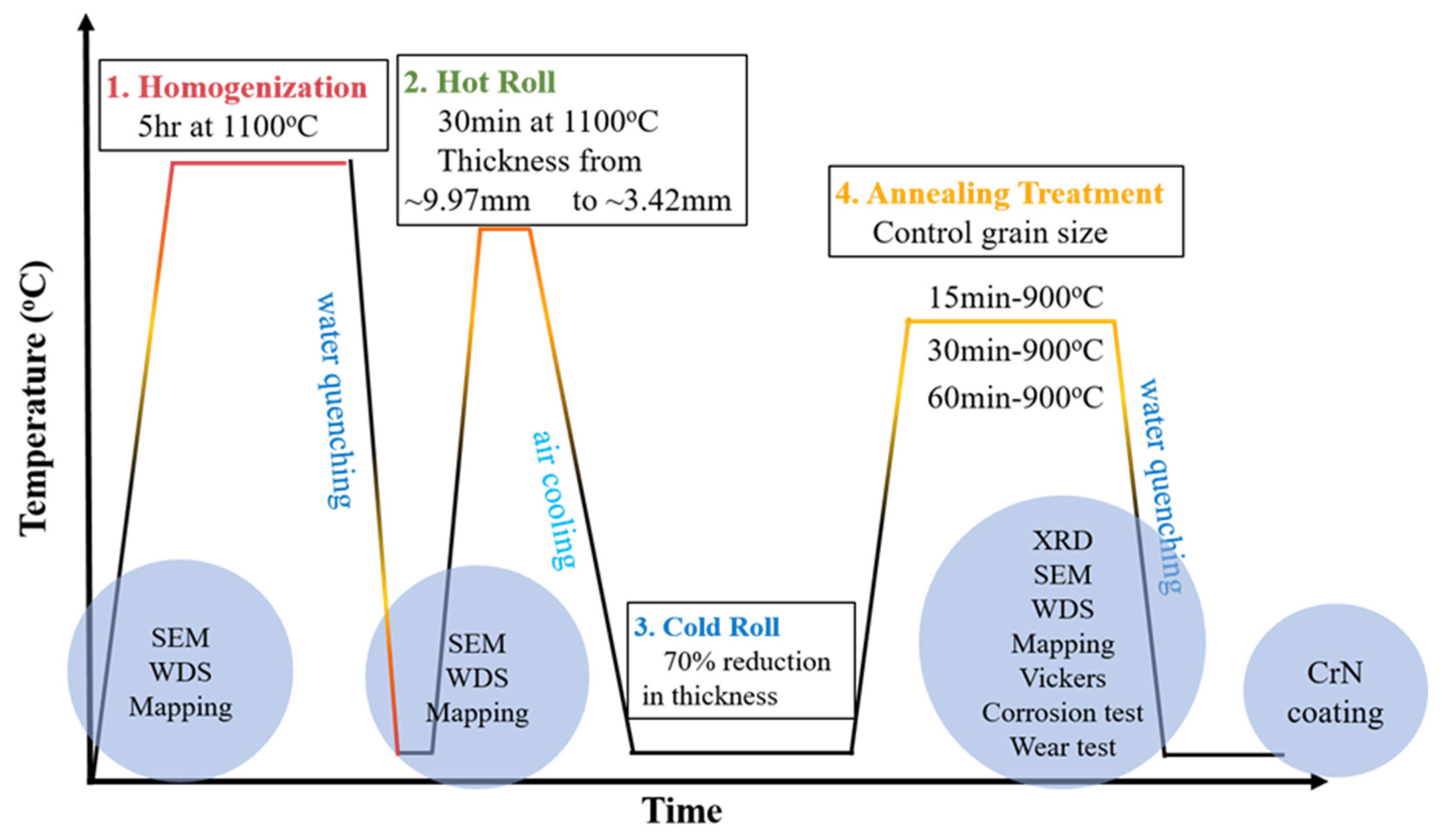
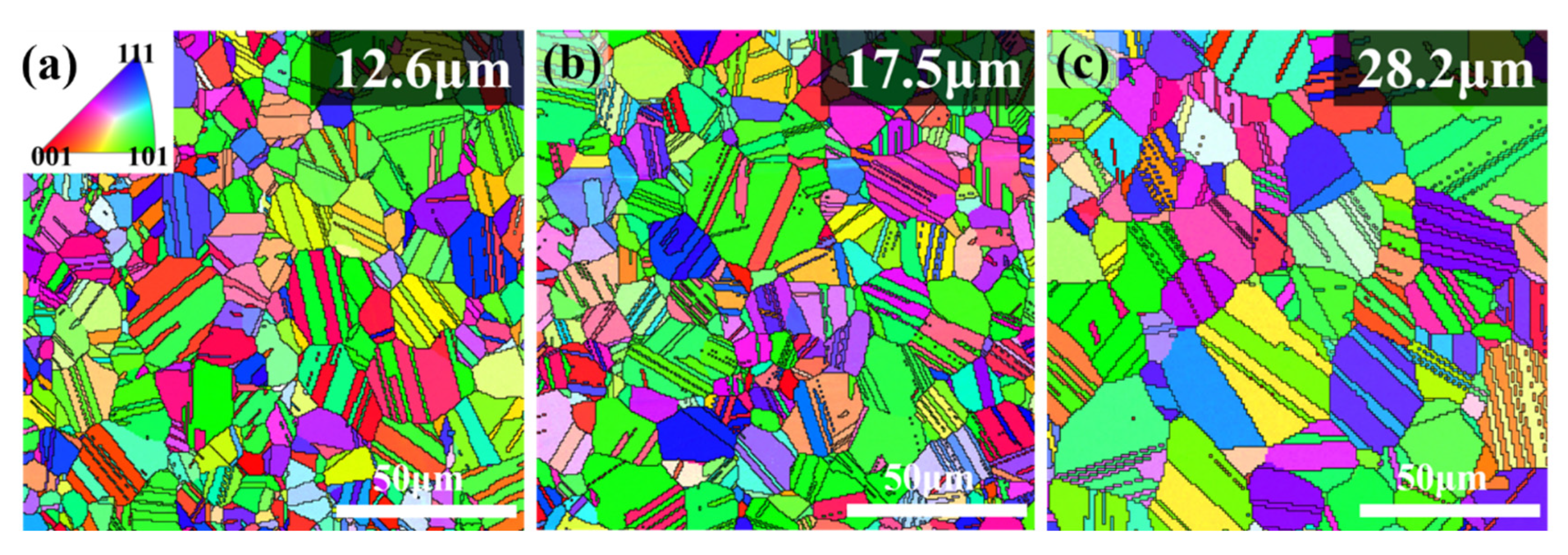
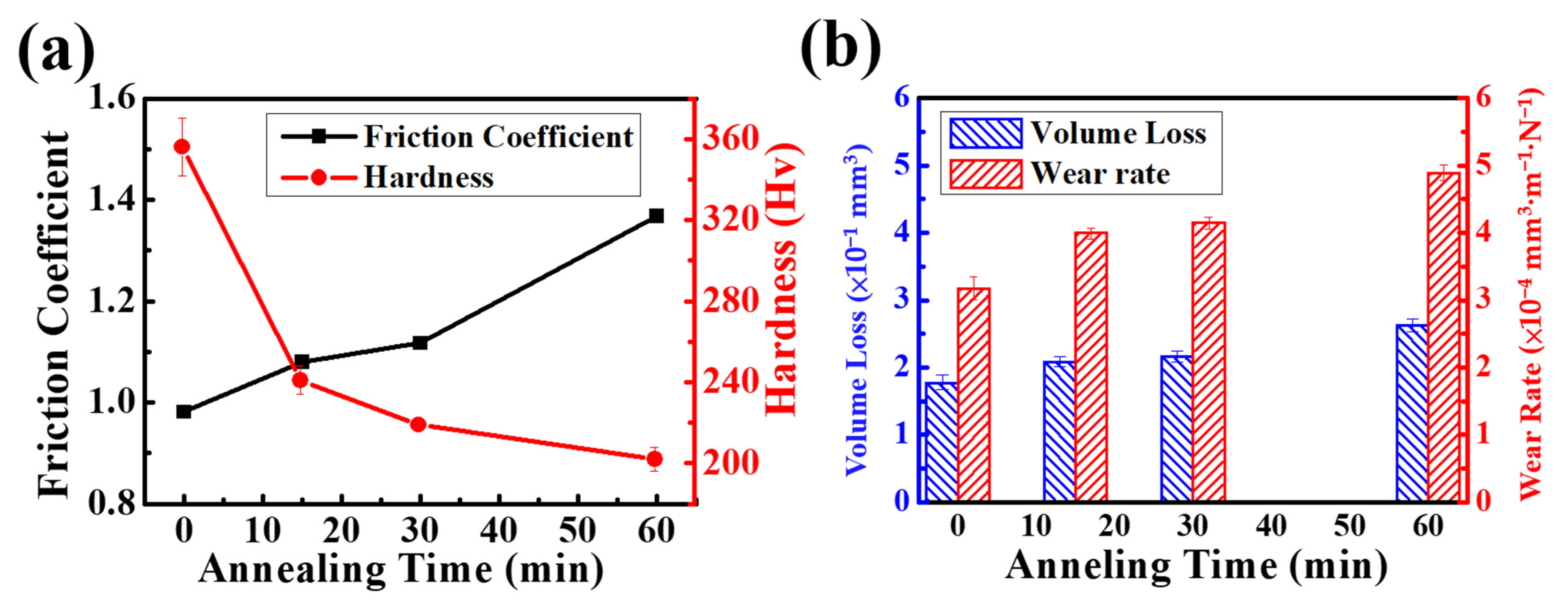
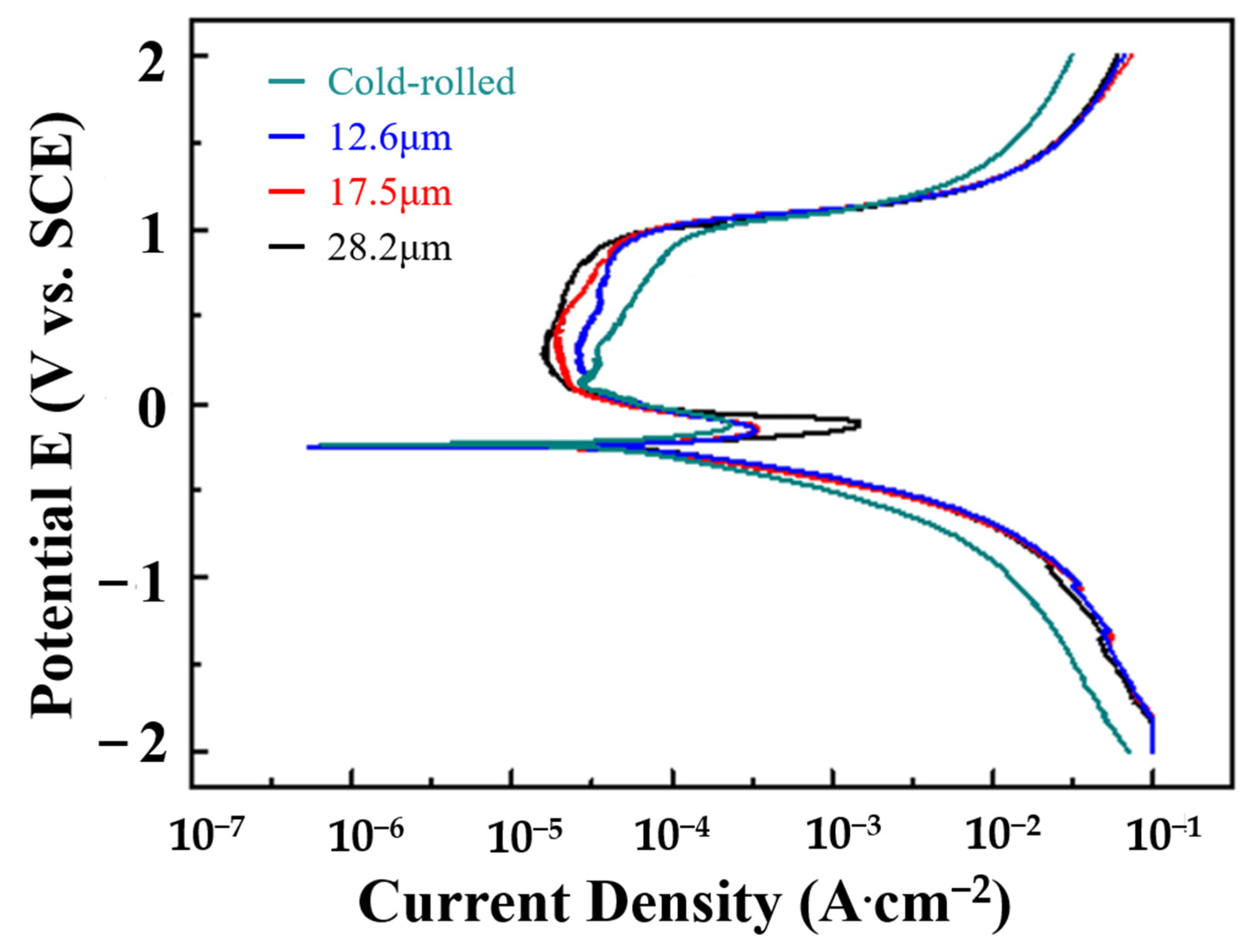
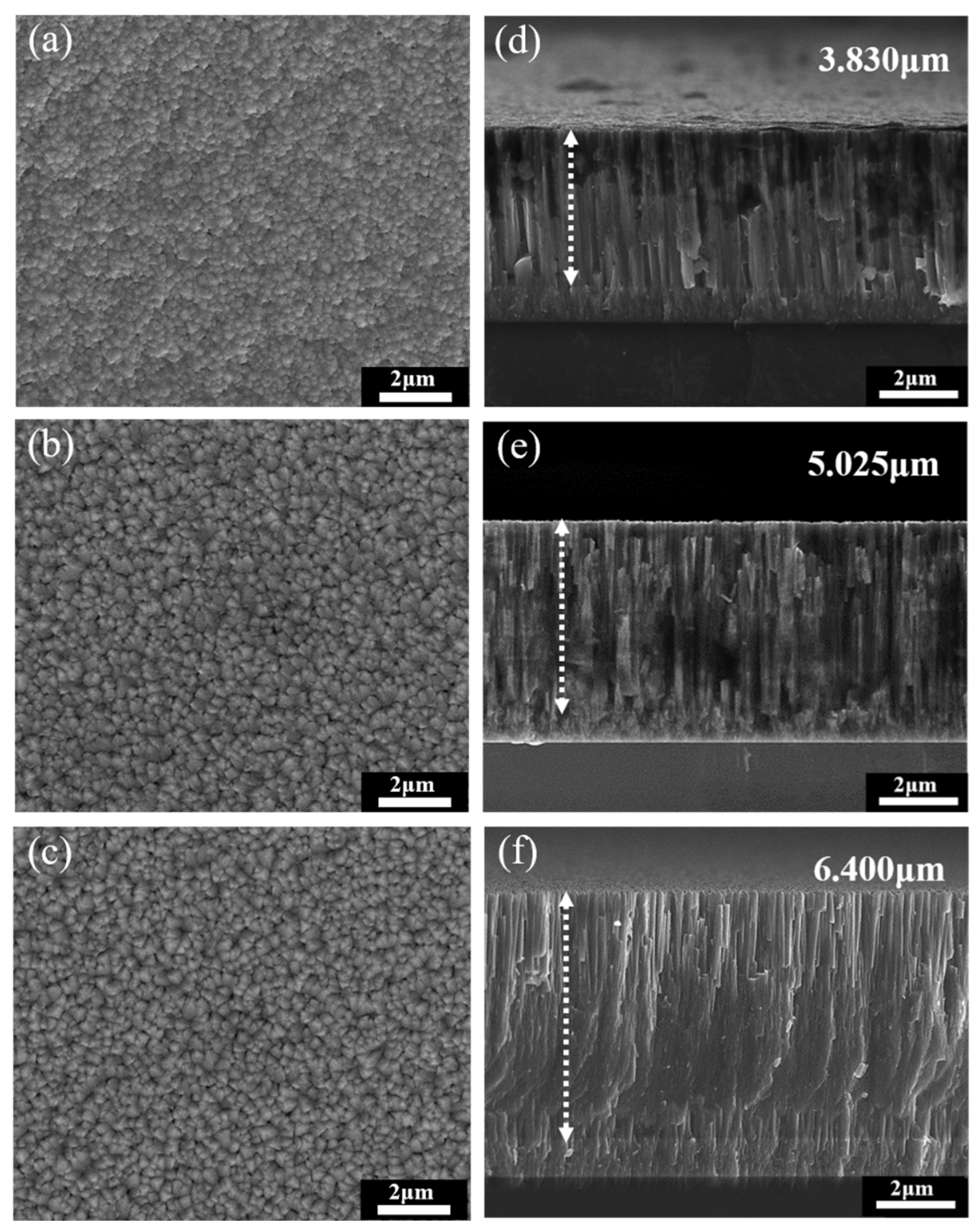
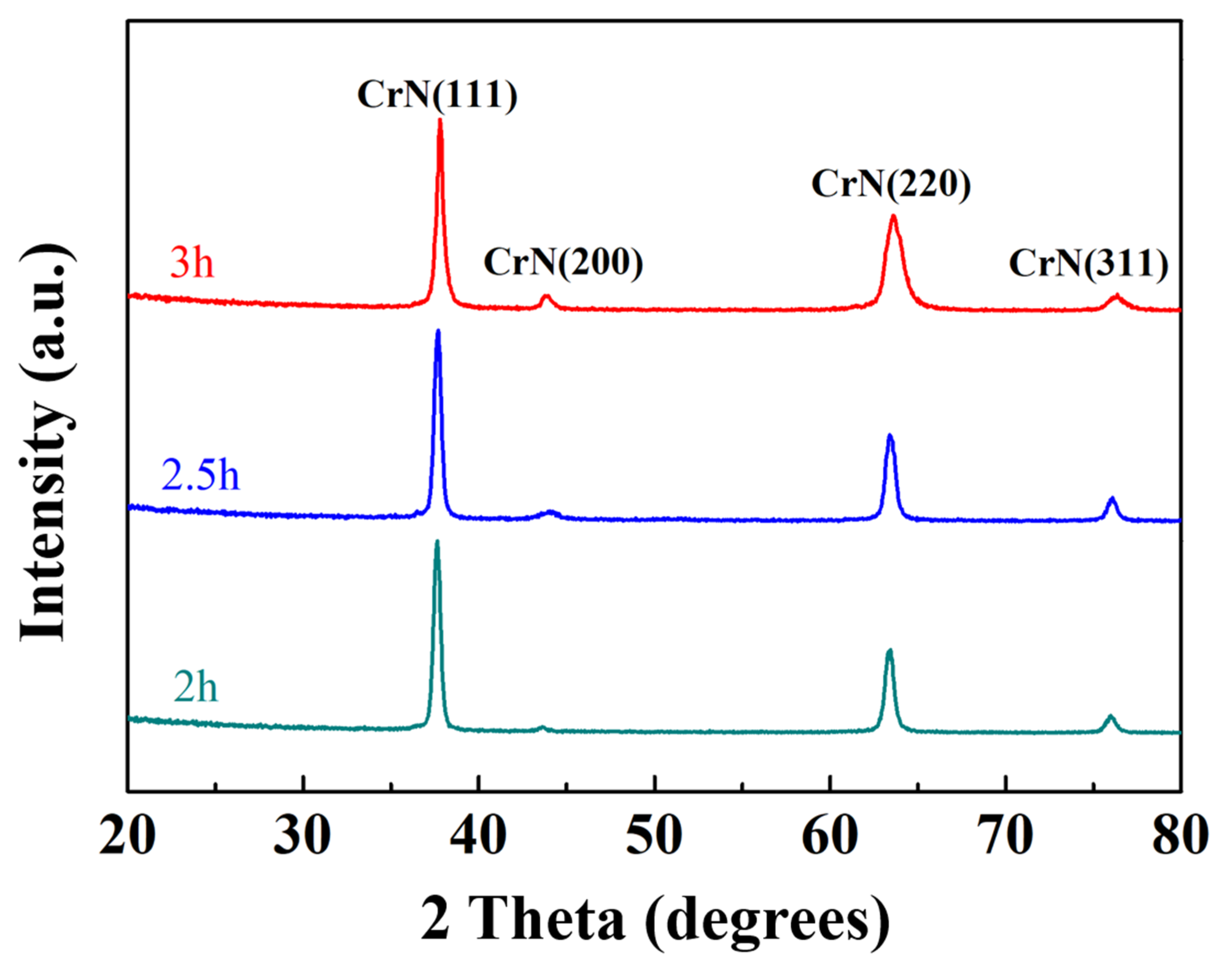

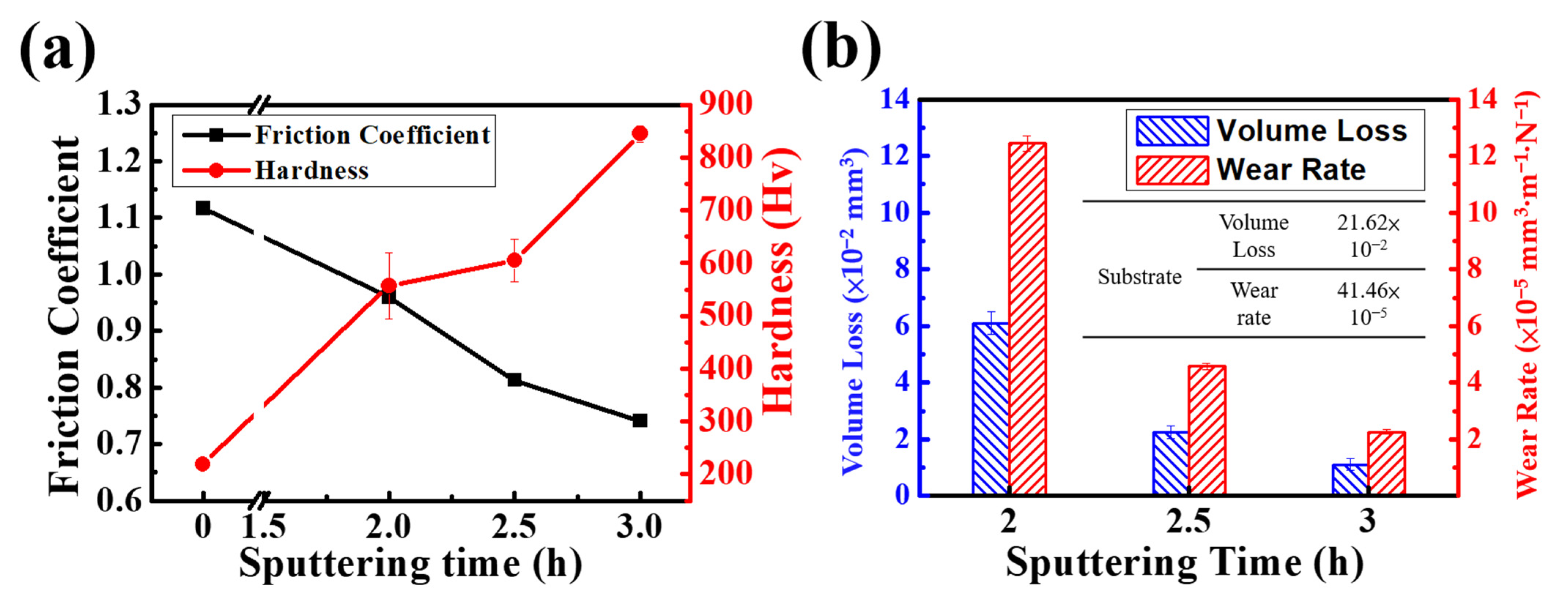
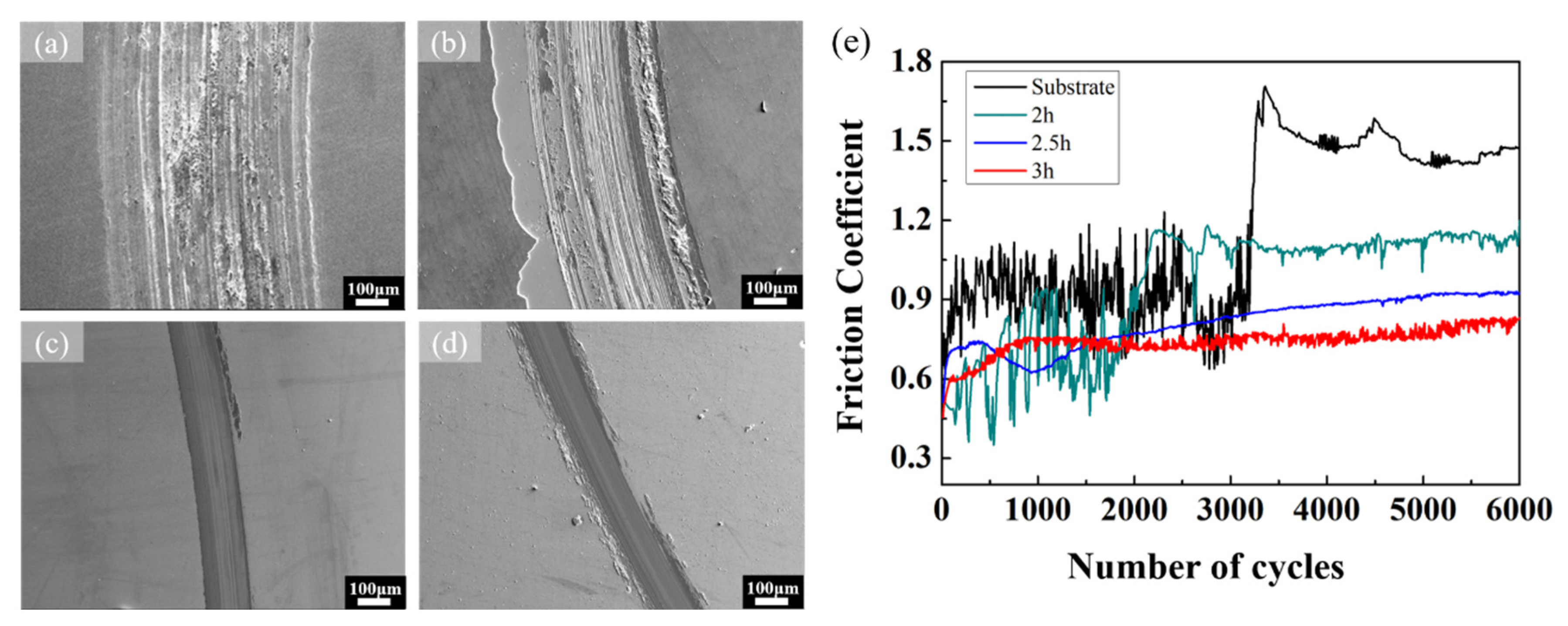



| Annealing Time (min) | Friction Coefficient | Hardness (Hv) | Volume Loss (×10−1 mm3) | Wear Rate (×10−4 mm3· m−1·N−1) |
|---|---|---|---|---|
| 0 | 0.981 | 356 ± 14 | 1.773 | 3.174 |
| 15 | 1.080 | 241 ± 7 | 2.081 | 3.994 |
| 30 | 1.117 | 219 ± 3 | 2.162 | 4.146 |
| 60 | 1.367 | 199 ± 6 | 2.626 | 4.896 |
| Annealing Time (min) | Icorr (μA·cm−2) | Ecorr (mV) | Rp (Ω·cm2) |
|---|---|---|---|
| 0 | 470.72 | −0.230 | 98.82 |
| 15 | 236.05 | −0.223 | 178.15 |
| 30 | 136.88 | −0.214 | 243.26 |
| 60 | 113.51 | −0.213 | 278.03 |
| Sputtering Time (h) | Friction Coefficient | Hardness (Hv) | Volume Loss (×10−2 mm3) | Wear Rate (×10−5 mm3· m−1·N−1) |
|---|---|---|---|---|
| 0 | 1.117 | 219 ± 3 | 21.620 | 41.460 |
| 2 | 0.960 | 557 ± 62 | 6.102 | 12.450 |
| 2.5 | 0.813 | 605 ± 40 | 2.245 | 4.581 |
| 3 | 0.741 | 845 ± 15 | 1.102 | 2.249 |
| Sputtering Time (h) | Wear Track Width (μm) | Wear Depth (μm) |
|---|---|---|
| 0 | 524.3 | 16.91 |
| 2 | 380.7 | 7.11 |
| 2.5 | 175.2 | 3.76 |
| 3 | 142.5 | 2.86 |
| Sputtering Time (h) | Icorr (μA·cm−2) | Ecorr (mV) | Rp (Ω·cm2) |
|---|---|---|---|
| 0 | 136.88 | −0.214 | 243.26 |
| 2 | 103.14 | −0.455 | 402.72 |
| 2.5 | 39.98 | −0.420 | 650.22 |
| 3 | 19.37 | −0.415 | 705.85 |
Disclaimer/Publisher’s Note: The statements, opinions and data contained in all publications are solely those of the individual author(s) and contributor(s) and not of MDPI and/or the editor(s). MDPI and/or the editor(s) disclaim responsibility for any injury to people or property resulting from any ideas, methods, instructions or products referred to in the content. |
© 2023 by the authors. Licensee MDPI, Basel, Switzerland. This article is an open access article distributed under the terms and conditions of the Creative Commons Attribution (CC BY) license (https://creativecommons.org/licenses/by/4.0/).
Share and Cite
Chang, Y.-C.; Lin, K.; Ma, J.-L.; Huang, H.-F.; Chang, S.-H.; Lin, H.-C. Improvement of Corrosion and Wear Resistance of CoCrNiSi0.3 Medium-Entropy Alloy by Sputtering CrN Film. Materials 2023, 16, 1482. https://doi.org/10.3390/ma16041482
Chang Y-C, Lin K, Ma J-L, Huang H-F, Chang S-H, Lin H-C. Improvement of Corrosion and Wear Resistance of CoCrNiSi0.3 Medium-Entropy Alloy by Sputtering CrN Film. Materials. 2023; 16(4):1482. https://doi.org/10.3390/ma16041482
Chicago/Turabian StyleChang, Yi-Chun, Kaifan Lin, Ju-Lung Ma, Han-Fu Huang, Shih-Hsien Chang, and Hsin-Chih Lin. 2023. "Improvement of Corrosion and Wear Resistance of CoCrNiSi0.3 Medium-Entropy Alloy by Sputtering CrN Film" Materials 16, no. 4: 1482. https://doi.org/10.3390/ma16041482
APA StyleChang, Y.-C., Lin, K., Ma, J.-L., Huang, H.-F., Chang, S.-H., & Lin, H.-C. (2023). Improvement of Corrosion and Wear Resistance of CoCrNiSi0.3 Medium-Entropy Alloy by Sputtering CrN Film. Materials, 16(4), 1482. https://doi.org/10.3390/ma16041482







